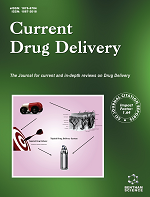- Home
- A-Z Publications
- Current Drug Delivery
- Previous Issues
- Volume 19, Issue 6, 2022
Current Drug Delivery - Volume 19, Issue 6, 2022
Volume 19, Issue 6, 2022
-
-
Cubosomes: Versatile Nanosized Formulation for Efficient Delivery of Therapeutics
More LessAuthors: Keshav Singhal, Niranjan Kaushik and Amrish KumarCubosomes are bicontinuous cubic phase nanoparticles with a size range from 10-500 nm. They offer various advantages with some limitations at the production level, e.g., cubosomes have the feature to encapsulate a large amount of the drug due to its large internal area owing to cuboidal shape but limited in large scale production due to its high viscosity which is associated with the problem in homogenization. This nanopa Read More
-
-
-
A Comprehensive Review on Hydrogels
More LessThe conventional drug delivery systems have a long list of repeated dosing and toxicity issues. The hydrogels solve these issues as they minimize such activities and optimize therapeutic benefits. The hydrogels possess tunable properties that can withstand degradation, metabolism, and control release moieties. Some areas of applications of hydrogels involve wound healing, ocular systems, vaginal gels, scaffolds for tissu Read More
-
-
-
Sulfonamide-Functionalized Polymeric Nanoparticles for Enhanced In Vivo Colorectal Cancer Therapy
More LessBackground: Colorectal cancer (CRC) is the third most common cancer in the world. 5- Fluorouracil (5-FU) is a conventional and most effective drug used in the clinic for the treatment of CRC. However, the clinical use of 5-FU is limited due to the acquired resistance and systemic toxicity, such as hepatotoxicity and gastrointestinal toxicity. Objective: Recent advances in nanomedicine are being exploited to develop nanoparticle plat Read More
-
-
-
Formulation and Evaluation of Hydroxypropylmethylcellulose-dicyclomine Microsponges for Colon Targeted Drug Delivery: In Vitro and In Vivo Evaluation
More LessObjective: The objective of the present study was to design novel colon targeted delivery of Dicyclomine Hydrochloride (DCH) microsponges. Methods: Microsponges (MS1-MS4) based on different ratios of Hydroxypropylmethylcellulose (HPMC) and DCH were prepared by quasi-emulsion solvent diffusion method. Micro-sponges were analyzed by determining percent yield, encapsulation efficiency, drug content, drug-poly Read More
-
-
-
Adsorption of Cisplatin on Oxidized Graphene Nanoribbons for Improving the Uptake in Non-small Cell Lung Carcinoma Cell Line A549
More LessAuthors: Steffi Augustine, Bala Prabhakar and Pravin ShendeBackground: Graphene nanoribbons are nanosized strips of graphene with unique physicochemical properties like higher drug loading capacity and affinity for tumor cells. Objective: The principal objective of this research was to develop oxidized graphene nanoribbons (O-GNRs)-based delivery system for cisplatin against non-small cell lung carcinoma cell line A549 by selective endocytosis. Methods: The O-GNRs prepared using Read More
-
-
-
Nanostructured Ethosomal Gel Loaded with Arctostaphylosuva-Ursi Extract; In-Vitro/In-Vivo Evaluation as a Cosmeceutical Product for Skin Rejuvenation
More LessAuthors: Nayla Javed, Shakeel Ijaz, Naveed Akhtar and Haji Muhammad Shoaib KhanBackground: Arctostaphylosuva-ursi(AUU) being rich in polyphenols and arbutin is known to have promising biological activities and can be a potential candidate as a cosmaceutical. Ethosomes encourage the formation of lamellar-shaped vesicles with improved solubility and entrapment of many drugs including plant extracts. Objective: The objective of this work was to develop an optimized nanostructured ethosomal gel Read More
-
-
-
Formulation Optimization and In Vitro Characterization of Granisetronloaded Polylactic-co-glycolic Acid Microspheres Prepared by a Dropping-in-liquid Emulsification Technique
More LessAuthors: Atef M. Q. Ahmed, Li-Qing Chen, Huan-Huan Du, Wei Sun and Qing-Ri CaoPurpose: Traditional dosage forms of granisetron (GRN) decrease patient compliance associated with repeated drug administration because of the short half-life of the drug. Methods: In this study, novel GRN-loaded Polylactic-co-glycolic Acid (PLGA) sustained-release microspheres were prepared for the first time via a dropping-in-liquid emulsification technique. The effects of various factors, such as pH of the outer phase Read More
-
Volumes & issues
-
Volume 22 (2025)
-
Volume 21 (2024)
-
Volume 20 (2023)
-
Volume 19 (2022)
-
Volume 18 (2021)
-
Volume 17 (2020)
-
Volume 16 (2019)
-
Volume 15 (2018)
-
Volume 14 (2017)
-
Volume 13 (2016)
-
Volume 12 (2015)
-
Volume 11 (2014)
-
Volume 10 (2013)
-
Volume 9 (2012)
-
Volume 8 (2011)
-
Volume 7 (2010)
-
Volume 6 (2009)
-
Volume 5 (2008)
-
Volume 4 (2007)
-
Volume 3 (2006)
-
Volume 2 (2005)
-
Volume 1 (2004)
Most Read This Month
Article
content/journals/cdd
Journal
10
5
false
en

Most Cited Most Cited RSS feed
-
-
Preface
Authors: Deng-Guang Yu and He Lv
-
- More Less

